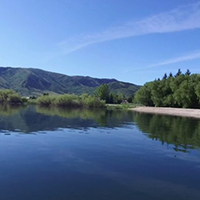Exploiting high frequency monitoring and satellite imagery for assessing chlorophyll-a dynamics in a shallow eutrophic lake

Submitted: 8 May 2021
Accepted: 15 June 2021
Published: 13 July 2021
Accepted: 15 June 2021
Abstract Views: 1393
PDF: 252
Supplementary 1: 48
Supplementary 2: 53
Supplementary 3: 52
HTML: 59
Supplementary 1: 48
Supplementary 2: 53
Supplementary 3: 52
HTML: 59
Publisher's note
All claims expressed in this article are solely those of the authors and do not necessarily represent those of their affiliated organizations, or those of the publisher, the editors and the reviewers. Any product that may be evaluated in this article or claim that may be made by its manufacturer is not guaranteed or endorsed by the publisher.
All claims expressed in this article are solely those of the authors and do not necessarily represent those of their affiliated organizations, or those of the publisher, the editors and the reviewers. Any product that may be evaluated in this article or claim that may be made by its manufacturer is not guaranteed or endorsed by the publisher.
Similar Articles
- Chang-Chun Huang, Yun-Mei Li, Hao Yang, Qiao Wang, Jun-Sheng Li, Xia Chen, Underwater light field determined by water constituents in highly turbid water: the case of Taihu lake , Journal of Limnology: Vol. 72 No. 1 (2013)
- Giuseppe Garlasché, Giulia Borgomaneiro, Roberta Piscia, Marina Manca, Ester M. Eckert, Diego Fontaneto, Metabarcoding to monitor the crustacean zooplankton of a lake improves when using a reference DNA library from local samples , Journal of Limnology: Vol. 82 (2023)
- María G. Cano, María A. Casco, María C. Claps, Epipelon dynamics in a shallow lake through a turbid-and a clear- water regime , Journal of Limnology: Vol. 75 No. 2 (2016)
- Margarita Caballero, Alejandro Rodriguez, Gloria Vilaclara, Beatriz Ortega, Priyadarsi Roy, Socorro Lozano-García, Hydrochemistry, ostracods and diatoms in a deep, tropical, crater lake in Western Mexico , Journal of Limnology: Vol. 72 No. 3 (2013)
- Jana Petruželová, Jindřiška Bojková, Jan Sychra, Vanda Šorfová, Vendula Polášková, Jaroslav Vrba, Complex effects of acidification, habitat properties and fish stock on littoral macroinvertebrate assemblages in montane standing waters , Journal of Limnology: Vol. 81 (2022)
- Markus A. Hoffmann, Alberto Benavent González, Uta Raeder, Arnulf Melzer, Experimental weed control of Najas marina ssp. intermedia and Elodea nuttallii in lakes using biodegradable jute matting , Journal of Limnology: Vol. 72 No. 3 (2013)
- Xu Sun, Zhixin Hu, Wen Jia, Cuilan Duan, Liuyan Yang, Decaying cyanobacteria decrease N2O emissions related to diversity of intestinal denitrifiers of Chironomus plumosus , Journal of Limnology: Vol. 74 No. 2 (2015)
- Andrea Fenocchi, Stefano Sibilla, Hydrodynamic modelling and characterisation of a shallow fluvial lake: a study on the Superior Lake of Mantua , Journal of Limnology: Vol. 75 No. 3 (2016)
- Michael A. Figueroa-Sanchez, Nandini Sarma, S.S.S. Sarma, Zooplankton community structure in the presence of low levels of cyanotoxins: a case study in a high altitude tropical reservoir (Valle de Bravo, Mexico) , Journal of Limnology: Vol. 73 No. 1 (2014)
- Pol Tarrats, Miguel Cañedo-Argüelles, Maria Rieradevall, Narcís Prat, Chironomid communities as indicators of local and global changes in an oligotrophic high mountain lake (Enol Lake, Northwestern Spain) , Journal of Limnology: Vol. 76 No. 2 (2017)
<< < 10 11 12 13 14 15 16 17 18 19 > >>
You may also start an advanced similarity search for this article.

 https://doi.org/10.4081/jlimnol.2021.2033
https://doi.org/10.4081/jlimnol.2021.2033






